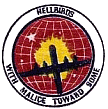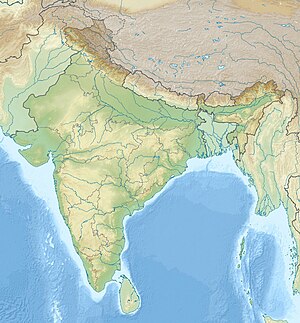Piardoba Airfield
This article includes a improve this article by introducing more precise citations. (September 2010) ) |
| Piardoba Airfield | |
|---|---|
| Part of Twentieth Air Force Tenth Air Force | |
| BANKURA DIST., WEST BENGAL, India | |
 Bell-Atlanta B-29-10-BA Superfortress at Piardoba Airfield | |
| Coordinates | 22°59′21.86″N 087°17′59.00″E / 22.9894056°N 87.2997222°E |
| Type | Military airfield |
| Site information | |
| Condition | Abandoned |
| Site history | |
| Built | 1942 |
| In use | 1942-1945 |
| Battles/wars | World War II |
Piardoba Airfield is an abandoned airfield in
History

During
Piardoba was originally designed for Consolidated B-24 Liberator use. In 1943 it was designated as a Boeing B-29 Superfortress base for the planned deployment of the United States Army Air Forces XX Bomber Command to India. Advance Army Air Forces echelons arrived in India in December 1943 to organize the upgrading of the airfield and thousands of Indians labored to upgrade the facility for Superfortress operations. It was one of four B-29 bases established by the Americans in India.
Piardoba was designated to be the home of the
. Support elements of the group included the 9th, 10th, 11th and 12th Bomb Maintenance Squadrons; the 13th Photo Lab, and the 86th Air Service Group.The 462d arrived at the base on 7 April 1944 after completing B-29 transition training at
, before arriving at Karachi. By the time the group arrived at Piardoba, the month-long trip had taken its toll on the aircraft and personnel.The 462dth was part of the
However, in order to stage missions and operate from Kuinglai, the group need to transport supplies of fuel, bombs, and spares needed 1,200 miles to the airfield. Six round trips were necessary to deliver enough fuel for one airplane to mount a combat mission from China - an impractical logistics concept for an aerial campaign.
Almost immediately upon arrival in India, engine fires caused the grounding of all of the groups B-29s. The cause was that the B-29's R-3350 engine had not been designed to operate at ground temperatures higher than 115 degrees F, which were typically exceeded in India. Modifications had also to be made to the aircraft and after these modifications, B-29 flights to India were resumed.
The first combat mission by the group took place on June 5, 1944, when squadrons of the 462d took off from India to attack the Makasan railroad yards at Bangkok, Thailand. This involved a 2261-mile round trip, the longest bombing mission yet attempted during the war.
On June 15 the group participated in the first American Air Force attack on the
The 462d evacuated staging fields in China in January 1945 due to the Japanese offensive in South China which threatened the forward staging bases, but continued operations from India, bombing targets in Thailand and mining waters around Singapore. However, by late 1944 it was becoming apparent that B-29 operations against Japan staged out of the bases in Chengtu were far too expensive in men and materials and would have to be stopped. In December 1944, the Joint Chiefs of Staff made the decision that Operation Matterhorn would be phased out, and the B-29s would be moved to newly captured bases in the Marianas in the central Pacific.
On 26 February 1945, the 462d Bombardment Group flew south to
With the departure of the B-29s to the Marianas, Piardoba Airfield was turned over to the
Also, Piardoba saw the arrival of Headquarters, Tenth Air Force from
Piardoba Airfield officially closed on 26 September 1945, being turned over to the British colonial government. The postwar history of the airfield is unclear, however today the large, sprawling wartime airfield is abandoned and in disrepair, with abandoned hardstands and taxiways visible on aerial images. Little no wartime structures still exist, although it appears that some small villages have taken over the former billeting areas.[5]
See also
References
- ISBN 978-1-56311-468-7.
- ^ MPost (2023-11-02). "Law student held for molesting classmate". www.millenniumpost.in. Retrieved 2023-11-02.
- ISBN 978-1-78337-619-3.
- ISBN 0-89201-092-4.
- ^ "Piardoba Airfield .:: World War II and now ::". www.midnapore.in. Retrieved 2023-11-02.
External links
 This article incorporates public domain material from the Air Force Historical Research Agency
This article incorporates public domain material from the Air Force Historical Research Agency Media related to Piardoba Airfield at Wikimedia Commons
Media related to Piardoba Airfield at Wikimedia Commons






